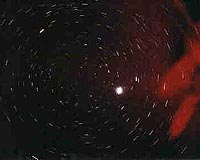 |
Rohnert Park CA (SPX) Jan 06, 2010 Radio astronomers have uncovered 17 millisecond pulsars in our galaxy by studying unknown high-energy sources detected by NASA's Fermi Gamma-ray Space Telescope. The astronomers made the discovery in less than three months. Such a jump in the pace of locating these hard-to-find objects holds the promise of using them as a kind of "galactic GPS" to detect gravitational waves passing near Earth. A pulsar is the rapidly spinning and highly magnetized core left behind when a massive star explodes. Because only rotation powers their intense gamma-ray, radio and particle emissions, pulsars gradually slow as they age. But the oldest pulsars spin hundreds of times per second - faster than a kitchen blender. These millisecond pulsars have been spun up and rejuvenated by accreting matter from a companion star. "Radio astronomers discovered the first millisecond pulsar 28 years ago," said Paul Ray at the Naval Research Laboratory in Washington. "Locating them with all-sky radio surveys requires immense time and effort, and we've only found a total of about 60 in the disk of our galaxy since then. Fermi points us to specific targets. It's like having a treasure map." Millisecond pulsars are nature's most precise clocks, with long-term, sub-microsecond stability that rivals human-made atomic clocks. Precise monitoring of timing changes in an all-sky array of millisecond pulsars may allow the first direct detection of gravitational waves - a long-sought consequence of Einstein's relativity theory. "The Global Positioning System uses time-delay measurements among satellite clocks to determine where you are on Earth," explained Scott Ransom of the National Radio Astronomy Observatory in Charlottesville, Va. "Similarly, by monitoring timing changes in a constellation of suitable millisecond pulsars spread all over the sky, we may be able to detect the cumulative background of passing gravitational waves." The sources Fermi detected are not associated with any known gamma-ray emitting objects and did not show evidence of pulsing behavior. However, scientists considered it likely that many of the unidentified sources would turn out to be pulsars. For a more detailed look at radio wavelengths, Ray organized the Fermi Pulsar Search Consortium and recruited a handful of radio astronomers with expertise in using five of the world's largest radio telescopes - the National Radio Astronomy Observatory, Robert C. Byrd Green Bank Telescope in W.Va., the Parkes Observatory in Australia, the Nancay Radio Telescope in France, the Effelsberg Radio Telescope in Germany and the Arecibo Telescope in Puerto Rico. After studying approximately 100 targets, and with a computationally intensive data analysis still under way, the discoveries have started to pour in. "Other surveys took a decade to find as many of these pulsars as we have," said Ransom, who led one of the discovery groups. "Having Fermi tell us where to look is a huge advantage." Four of the new objects are "black widow" pulsars, so called because radiation from the recycled pulsar is destroying the companion star that helped spin it up. "Some of these stars are whittled down to masses equivalent to tens of Jupiters," said Ray. "We've doubled the known number of these systems in the galaxy's disk, and that will help us better understand how they evolve."
Share This Article With Planet Earth
Related Links Fermi at NASA Universe at Sonoma Space Tourism, Space Transport and Space Exploration News
 A New Way To Measure Cosmic Distances
A New Way To Measure Cosmic DistancesPasadena CA (SPX) Jun 09, 2009 Ohio State University researchers have found a way to measure distances to objects three times farther away in outer space than previously possible, by extending a common measurement technique. They discovered that a rare type of giant star, often overlooked by astronomers, could make an excellent signpost for distances up to 300 million light-years - and beyond. Along the way, they also ... read more |
|
| The content herein, unless otherwise known to be public domain, are Copyright 1995-2009 - SpaceDaily. AFP and UPI Wire Stories are copyright Agence France-Presse and United Press International. ESA Portal Reports are copyright European Space Agency. All NASA sourced material is public domain. Additional copyrights may apply in whole or part to other bona fide parties. Advertising does not imply endorsement,agreement or approval of any opinions, statements or information provided by SpaceDaily on any Web page published or hosted by SpaceDaily. Privacy Statement |